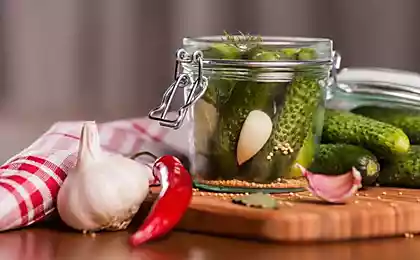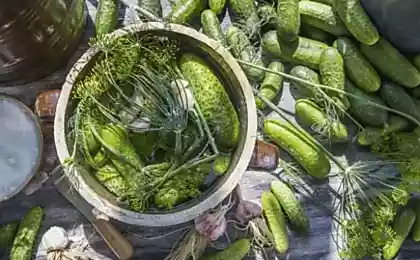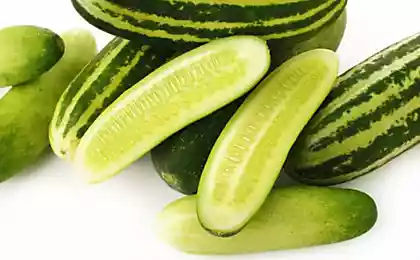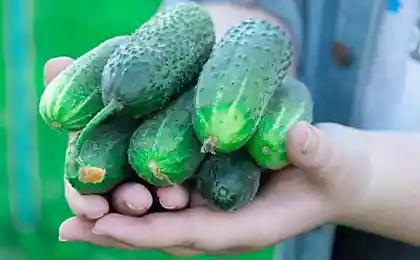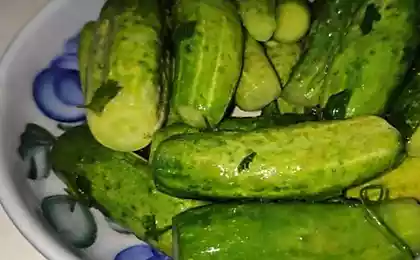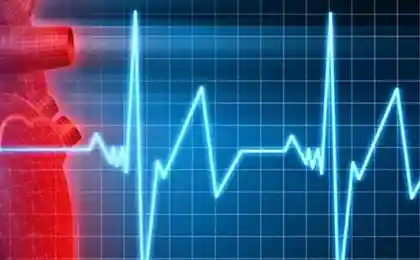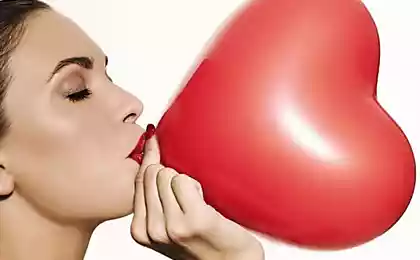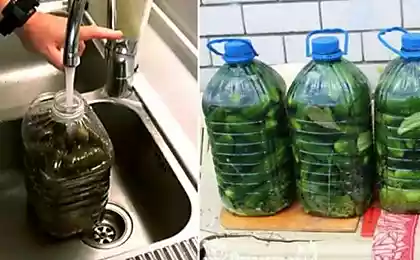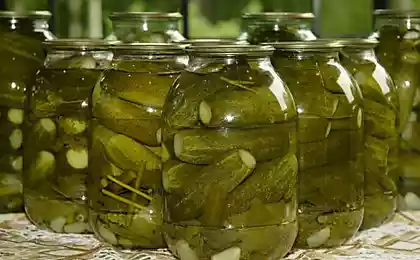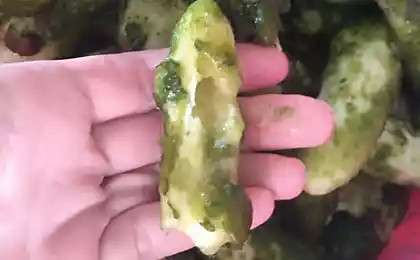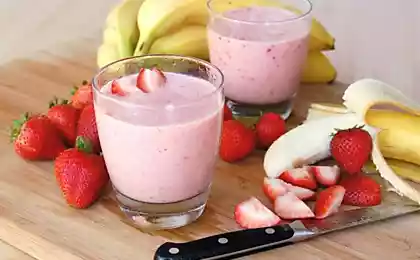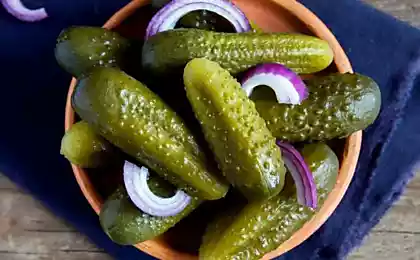465
Normalizing the pressure cucumbers

Ripe cucumbers — one of the first signs of truly coming summer. This is an excellent low calorie vegetable. For all its low caloric value it contains so little nutrients — not counting water and electrolytes, as it may seem at first glance. Cucumbers are one of the oldest cultivated by mankind plant species. It is believed that cucumbers are native to the Northern foothills of the Himalayas. Thus, this is an Indian vegetable. Cucumbers belong to the same family Cucurbitaceae (Cucurbitaceae), melon, zucchini, and pumpkin. Scientific name of cucumber is Cucumis sativus.
They are easy to grow. Cucumbers vary in size, shape and color and are cultivated worldwide in different climatic zones. Usually they have dark green skin and crisp flesh moist. In the midst of the fruit are small edible seeds.
Like other vegetables of the Cucurbitaceae family, cucumber is best to gather young, not fully matured. In this case, the taste will be sweet and will remain nice texture, and the flavor is almost neutral. If you do not collect them in this period, the fruits will continue to grow, their skins will become thick and turn yellow and the seeds become hard and inedible. Cucumbers can be eaten raw in vegetable salads, as well as squeeze out the juice.
American cucumbers are long, crisp, ridged and curved. They are characterized by light green color. Miniature varieties (including gherkins) are very small in size. They are usually pickled. Dosakai (Dosakayi) — Indian yellow cucumber curry. It has a mild sweet taste and neutral aroma. It is an ingredient in stews and curries. It is the most widely used summer in the South of India and Sri Lanka.
The benefits of cucumber for health
Cucumber is one of the least calorie vegetables. Its energy value per 100 grams only 15 calories. Saturated fat it contains. Cucumber peel is a good source of dietary fibre that helps reduce constipation, providing some protection against cancer of the colon by removing from the stomach of toxic compounds.
It is also a good source of potassium, an important intracellular electrolyte. 100 grams of cucumber contains 147 milligrams of potassium and only 2 milligrams of sodium. Potassium is an electrolyte that do not have harmful effects on the heart. Addressing provided by the sodium effect, it helps to reduce the total blood pressure and heart rate.
In moderation cucumbers also contain antioxidants, including beta and alpha carotenes, vitamins C and A as well as zeaxanthin and lutein. These compounds protect from harmful free radicals and reactive forms of oxygen absorbing them. The ability to absorb oxygen radicals (ORAC index of cucumbers is 214 µmol (micromol) TE/100 grams.
Cucumbers have mild diuretic properties, which are provided by the content of free water and potassium and low in sodium. This helps to keep increase in weight and blood pressure.
Surprisingly, cucumbers contain a lot of vitamin K — 17 micrograms per 100 grams. Presumably, vitamin K plays a role in strengthening bones, promoting osteotropic activity (formation of bone). Established its role in the treatment of patients with Alzheimer's disease, since this vitamin limits the damage to the neurons of the brain damage.
Selecting and storing cucumbers
Give preference to fresh cucumbers bright green color, firm and has a dense texture. Do not buy overripe yellow cucumbers, as their peel could be hard, and seeds inedible. Also avoid cucumbers with wrinkled edges, because they say that cucumbers are long and could lose its flavor.
Home thoroughly wash the cucumbers under running pure water to wash away the dirt and pesticide residues. The peel of some varieties of cucumbers has small "thorns" that should clean off. In those places where the surface of the vegetables stuck in the mud or are the spikes, they should be lightly scratched. Cut both tip and RUB the cut surface to remove the sticky whitish fluid that gives the cucumbers a bitter taste. Do not remove from cucumber peel, which contains vital minerals, fitohimikalii and fiber.
Store cucumbers at room temperature, but not more than one or two days. But even better to put them in the refrigerator, where at the appropriate relative humidity they will remain a few days.
Caution
Some cucumbers contain harmful bitterness, similar terpenoid toxins, such as cucurbitacin B,D,G,H, and others.
Before eating, you should try to taste a small piece of cucumber to make sure that he is not bitter. If it's bitter, then you should not eat this vegetable. In case of discomfort after consumption of cucumbers in food (nausea, vomiting, diarrhea and other unpleasant feelings) should immediately contact the doctor.
And, of course, in various diseases no cucumbers or other vegetables and fruits are not a replacement for the treatment that is appointed by the doctor.
Nutritional value of cucumbers
In parentheses are the percentage of the daily allowance. Nutritional value is based on 100 grams of raw cucumber (Cucumis sativus) according to information from the Ministry of agriculture of the USA, shown in the resource Nutrition And You.
General information:
energy value 15 kcal ( carbohydrates — 3.63 grams (3%);
protein — 0.65 grams (1%);
fats — 0.11 grams (0.5 per cent);
fiber, part of the food is 0.5 grams (1%).
Vitamins:
folic acid (vitamin B9) — 7 micrograms (2%);
nicotinic acid (vitamin B3) — 0,098 mg ( Pantothenic acid — 0,259 milligram (5%);
pyridoxine (vitamin B6) — 0,040 milligram (3%);
Riboflavin (vitamin B2) — 0,033 milligram (3%);
thiamine (vitamin B1) of 0.027 mg (2%);
vitamin a, which very much is contained in dandelion — 105 international units (IU, IU) — 3,5%;
vitamin C: 2.8 milligrams (4,5%);
vitamin E — 0.03 mg (~0%);
vitamin K, an incredibly rich source of which is sage — of 16.4 micrograms (13,6%);
Electrolytes:
sodium is 2 milligrams (~0%);
potassium — 147 mg (3%).
Minerals:
calcium, 16 milligrams (1,6%);
iron — 0.28 mg (3,5%);
magnesium — 13 mg (3%);
manganese — 0,079 mg (3,5%);
phosphorus 24 milligrams (3%);
zinc — 0.20 milligram (2%).
Phytonutrients:
beta-carotene (ß-carotene), which is rich in carrots — 45 micrograms;
beta-cryptoxanthin (ß-cryptoxanthin) — 26 micrograms;
lutein-zeaxanthin — 23 micrograms. published
P. S. And remember, only by changing their consumption — together we change the world! ©
Source: hi-news.ru
Scientists: where in Swiss cheese are the holes
NASA unveiled a new prototype electric airplane Greased Lightning

